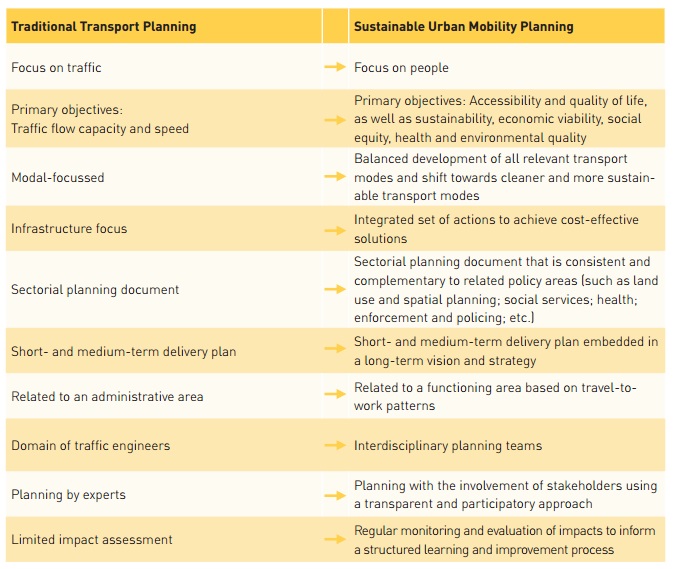“A Sustainable Urban Mobility Plan is a strategic plan designed to satisfy the mobility needs of people and businesses in cities and their surroundings for a better quality of life.” [1]
SUMPs: Sustainable Urban Mobility Plans
The Sustainable Urban Mobility Plan (SUMP) contributes to the European climate and energy goals set by the EU. The SUMP is a integrated planning concept that challenges transport related problems in a more sustainable way. Compared to traditional transport planning approaches, the SUMP focuses on the user, the citizen, rather than on vehicles and traffic. It can help to find a balance between mobility in urban areas and quality of life, with a focus on public health, climate change, oil dependency and noise and air pollution.
The main objectives are:
- Ensure all citizens are offered transport options that enable access to key destinations and services
- Improve safety and security;
- Reduce air and noise pollution, greenhouse gas emissions and energy consumption;
- Improve the efficiency and cost-effectiveness of the transportation of persons and goods;
- Contribute to enhancing the attractiveness and quality of the urban environment and urban design for the benefits of citizens, the economy and society as a whole
The main differences between a SUMP and a classic mobility plan are:

Source: www.eltis.org, Guidelines developing and implementing a SUMP
SUMPs in Europe
The European Commission provides guidance material, promotes best practice exchange and supports educational activities for urban mobility professionals. From the French experience, it takes minimum 1 year but up to 3 years to prepare a sustainable urban transport plan. The costs to develop a SUMP are between 200.000 and 400.000 EUR. Since 1996, all French cities with more than 100.000 inhabitants are obliged to develop a Sustainable Urban Mobility Plan (Plan de Déplacements Urbains –PDU).

Read more about SUMPs in France here (pdf)
SUMPs and cycling
Cycling is acknowledged as a potential solution to urban mobility challenges, even though the information on cycling is not specifically detailed in the SUMP-guidelines. In 2011, ELTIS had counted 325 cycling projects in SUMPs (besides 325 pedestrian projects and 770 road projects).
In SUMPs cycling is often part of “Active Mobility” together with walking; on the other hand cycling is considered as a full-fledged transport mode, presented as a potential alternative to private cars with a lot of health and environmental benefits. Cycling is also included in intermodality schemes. In the end, putting cycling on the SUMP agenda depends a lot of individual plans and authorities. Compared to a cycling plan, SUMPs have the capacity to attract all types of authorities, even those which have not thought about cycling in specific.
On www.eltis.org there are some SUMPs with a focus on cycling, for example in Budapest or cycle highways in Copenhagen.
Read more about SUMPs in in the News-Section.
What is keeping cities from starting SUMPs?
- no political will: SUMPs are a good thing and the guidelines full of common sense, but they can easily be shoved to the back of the shelf compared to other priorities (jobs, local economy, industry)
- no budget: If cities do manage to get political support and a budget to develop a SUMP is often a direct consequence. Sometimes there is budget for the planning part, but not for the implementation anymore.
- no data: another barrier they quickly stumble upon is the lack of data. Every SUMP should start with an analysis of the current situation. Unfortunately, many cities only have decent and detailed information about public transport and private motorized vehicles. For freight transport, cycling and walking, the data are either old, not harmonized or completely lacking.
SUMPs and ECF priorities have a lot in common:
- Sustainable mobility
- Intermodality
- Cleaner and more liveable cities
- Promotion of health
- Promotion of local economy
- Cost-effective solutions
- Accessibility of the solutions (social dimension)
- Address major problems: commuter traffic, congestion, pollution, road safety
visit http://www.eltis.org for further information about best practice examples, guidlines and more
[1] http://www.eltis.org/sites/eltis/files/guidelines-developing-and-implementing-a-sump_final_web_jan2014b.pdf
